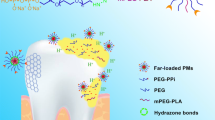ABSTRACT
Purpose
To develop tooth-binding micelle formulations of triclosan for the prevention and treatment of dental caries.
Methods
Alendronate (ALN) was conjugated to the chain termini of different Pluronic copolymers to confer tooth-binding ability to the micelles. Using 3 different formulation methods, Pluronics and ALN-modified Pluronics were used to prepare triclosan-loaded tooth-binding micelles. The formulation parameters were optimized for triclosan solubility, particle size, hydroxyapatite (HA) binding capability and in vitro drug release profile. The optimized formulation was tested on an in vitro biofilm model.
Results
Direct dissolution was selected as the best formulation method. Triclosan-loaded tooth-binding micelles were able to inhibit initial biofilm growth of Streptococcus mutans UA159 by 6-log CFU/HA disc compared to the untreated control. These tooth-binding micelles were also able to reduce the viability of preformed biofilm by 4-log CFU/HA disc compared to the untreated control.
Conclusions
Triclosan-loaded tooth-binding micelle formulations have been successfully developed and optimized in this study. These micelle formulations demonstrated promising anti-cariogenic bacteria capabilities and may find applications in the prevention and treatment of dental caries.




Similar content being viewed by others
REFERENCES
Senadheera D, Cvitkovitch DG. Quorum sensing and biofilm formation by Streptococcus mutans. Adv Exp Med Biol. 2008;631:178–88.
Keyes PH. The infectious and transmissible nature of experimental dental caries. Findings and implications. Arch Oral Biol. 1960;1:304–20.
Loesche WJ. Role of Streptococcus mutans in human dental decay. Microbiol Rev. 1986;50:353–80.
Kuramitsu HK. Virulence factors of mutans streptococci: role of molecular genetics. Crit Rev Oral Biol Med. 1993;4:159–76.
Kuramitsu HK. Virulence properties of oral bacteria: impact of molecular biology. Curr Issues Mol Biol. 2001;3:35–6.
Bowden GH, Hamilton IR. Survival of oral bacteria. Crit Rev Oral Biol Med. 1998;9:54–85.
Marsh PD, Bradshaw DJ. Dental plaque as a biofilm. J Ind Microbiol. 1995;15:169–75.
Gilbert P, Das J, Foley I. Biofilm susceptibility to antimicrobials. Adv Dent Res. 1997;11:160–7.
Ceri H, Olson ME, Stremick C, Read RR, Morck D, Buret A. The Calgary Biofilm Device: new technology for rapid determination of antibiotic susceptibilities of bacterial biofilms. J Clin Microbiol. 1999;37:1771–6.
van der Ouderaaand F, Cummins D. Delivery systems for agents in supra- and sub-gingival plaque control. J Dent Res. 1989;68:1617–24.
Furiaand TE, Schenkel AG. A new, broad spectrum bacteriostat. Soap Chem Spec. 1968;44:47–50. 116–22.
Food and Drug Administration, FDA approves first toothpaste for gum disease, FDA Talk paper, July 14th (1997). FDA Talk paper.
Raghavan SL, Schuessel K, Davis A, Hadgraft J. Formation and stabilisation of triclosan colloidal suspensions using supersaturated systems. Int J Pharm. 2003;261:153–8.
Gilbert RJ, Williams PE. The oral retention and antiplaque efficacy of triclosan in human volunteers. Br J Clin Pharmacol. 1987;23:579–83.
Phan TN, Marquis RE. Triclosan inhibition of membrane enzymes and glycolysis of Streptococcus mutans in suspensions and biofilms. Can J Microbiol. 2006;52:977–83.
Bradshaw DJ, Marsh PD, Watson GK, Cummins D. The effects of triclosan and zinc citrate, alone and in combination, on a community of oral bacteria grown in vitro. J Dent Res. 1993;72:25–30.
Chen F, Liu XM, Rice KC, Li X, Yu F, Reinhardt RA et al. Tooth-binding micelles for dental caries prevention. Antimicrob Agents Chemother. 2009;53:4898–902.
Murchison HH, Barrett JF, Cardineau GA, Curtiss 3rd R. Transformation of Streptococcus mutans with chromosomal and shuttle plasmid (pYA629) DNAs. Infect Immun. 1986;54:273–82.
Biswas I, Drake L, Biswas S. Regulation of gbpC expression in Streptococcus mutans. J Bacteriol. 2007;189:6521–31.
Jett BD, Hatter KL, Huycke MM, Gilmore MS. Simplified agar plate method for quantifying viable bacteria. Biotechniques. 1997;23:648–50.
Wei Z, Hao J, Yuan S, Li Y, Juan W, Sha X et al. Paclitaxel-loaded Pluronic P123/F127 mixed polymeric micelles: formulation, optimization and in vitro characterization. Int J Pharm. 2009;376:176–85.
Blanco E, Bey EA, Dong Y, Weinberg BD, Sutton DM, Boothman DA et al. Beta-lapachone-containing PEG-PLA polymer micelles as novel nanotherapeutics against NQO1-overexpressing tumor cells. J Control Release. 2007;122:365–74.
Chiappetta DA, Degrossi J, Teves S, D’Aquino M, Bregni C, Sosnik A. Triclosan-loaded poloxamine micelles for enhanced topical antibacterial activity against biofilm. Eur J Pharm Biopharm. 2008;69:535–45.
Shinoda H, Adamek G, Felix R, Fleisch H, Schenk R, Hagan P. Structure-activity relationships of various bisphosphonates. Calcif Tissue Int. 1983;35:87–99.
Fujisawa R, Wada Y, Nodasaka Y, Kuboki Y. Acidic amino acid-rich sequences as binding sites of osteonectin to hydroxyapatite crystals. Biochim Biophys Acta. 1996;1292:53–60.
Yang L, Wu X, Liu F, Duan Y, Li S. Novel biodegradable polylactide/poly(ethylene glycol) micelles prepared by direct dissolution method for controlled delivery of anticancer drugs. Pharm Res. 2009;26:2332–42.
Oh KT, Bronich TK, Kabanov AV. Micellar formulations for drug delivery based on mixtures of hydrophobic and hydrophilic Pluronic block copolymers. J Control Release. 2004;94:411–22.
R. Nagarajan. Solubilization of hydrocarbons and resulting aggregate shape transitions in aqueous solutions of Pluronic® (PEO–PPO–PEO) block copolymers. Coll. Surf. B: Biointerf. 1999; 55–72.
Xu RL, Winnik MA, Hallett FR, Riess G, Croucher MD. Light-scattering study of the association behavior of styrene-ethylene oxide block copolymers in aqueous solution. Macromolecules. 1991;24:87–93.
Chu B, Zhou Z. Nonionic Surfactants: polyoxyalkylene block copolymers. New York: Marcel Dekker, Inc.; 1996.
Kabanov AV, Alakhov VY. Pluronic block copolymers in drug delivery: from micellar nanocontainers to biological response modifiers. Crit Rev Ther Drug Carrier Syst. 2002;19:1–72.
Croy SR, Kwon GS. Polymeric micelles for drug delivery. Curr Pharm Des. 2006;12:4669–84.
Kozlov MY, Melik-Nubarov NS, Batrakova EV, Kabanov AV. Relationship between Pluronic Block Copolymer Structure. Critical Micellization Concentration and Partitioning Coefficients of Low Molecular Mass Solutes. Macromolecules. 2000;33:3305–13.
Sjogren K, Lundberg AB, Birkhed D, Dudgeon DJ, Johnson MR. Interproximal plaque mass and fluoride retention after brushing and flossing–a comparative study of powered toothbrushing, manual toothbrushing and flossing. Oral Health Prev Dent. 2004;2:119–24.
ACKNOWLEDGMENT
This work was supported in part by NIH grants R03 DE019179 (KCR), R01 AI038901 (KWB) and R01 AR053325 (DW). We also acknowledge partial support of NIH COBRE grant RR021937 (Nebraska Center for Nanomedicine).
Author information
Authors and Affiliations
Corresponding authors
Rights and permissions
About this article
Cite this article
Chen, F., Rice, K.C., Liu, XM. et al. Triclosan-Loaded Tooth-Binding Micelles for Prevention and Treatment of Dental Biofilm. Pharm Res 27, 2356–2364 (2010). https://doi.org/10.1007/s11095-010-0119-5
Received:
Accepted:
Published:
Issue Date:
DOI: https://doi.org/10.1007/s11095-010-0119-5




